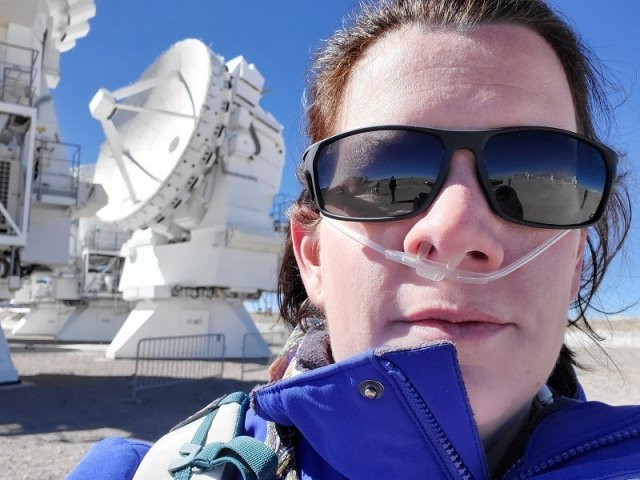Planetarium director attends Astronomy in Chile Educator Ambassadors Program
Planetarium director attends Astronomy in Chile Educator Ambassadors Program
Amy Barraclough, the director of the Fredric and Jean Edelman Planetarium, represented Rowan University on the international stage this summer through the Astronomy in Chile Educator Ambassadors Program (ACEAP).
Barraclough participated in a nine-day Chile expedition that included learning more about Chile’s astro-tourism industry and immersing herself in the Chilean culture.
The program is a collaboration between numerous astronomy-focused organizations and is supported by the National Science Foundation.
While in Chile, Barraclough worked with eight other ambassadors conducting research in astronomy. They visited some of the world’s most well-known observatories—the Gemini South Telescope in central Chile, Cerro Tololo Inter-American Observatory near La Serena and the ALMA facilities in San Pedro De Atacama in northern Chile. The program provided ambassadors with substantial training on the instruments used at the facilities and familiarized them with the research conducted there.
The experience, Barraclough said, sharpened their understanding of STEM (science, technology, engineering and mathematics) concepts, which are invaluable in the field of astronomy.
According to Barraclough, Chile was the perfect location to facilitate learning. Ambassadors were able to view aspects of the night sky from a unique vantage point.
“I was excited for the opportunity to see the Large and Small Magellanic Clouds, which are satellite galaxies of our own Milky Way galaxy and only visible in the southern hemisphere,” she said.
“The skies in Chile were some of the darkest I’ve ever experienced,” Barraclough continued. “On Jupiter, we could see the four brightest moons, some of the cloud bands, and even dark patches where a storm was brewing in the cloud tops. I’ve never seen anything like that before. On Saturn, we were able to see some of the cloud bands, too. They’re usually invisible to small ground-based telescopes because there isn’t as much difference in color on the clouds.”
Becoming an ACEAP ambassador is no easy task. The program is highly competitive and accepts a maximum of just 10 people annually, according to Barraclough. In previous years, more than 70 educators have applied to become ambassadors.
This year’s ambassadors included astronomy educators, communicators working in the field of astronomy and amateur astronomers. One Chilean educator who teaches astronomy also was selected for ACEAP.
Barraclough, who earned her bachelor’s degree in physics at the University of Wisconsin-Stevens Point, where she spent four years as a planetarium educator, said her passion of the night sky drives her work as the director of the Edelman Planetarium.
Since she became its director, the planetarium’s annual attendance has doubled, as has its public show schedule. She works to expand planetarium programs by partnering with class and student organizations, as well as hosting field trips for elementary schools across region.
In August of 2017, Barraclough was named Rowan’s PROFessional of the Month for organizing a community watch party for a solar eclipse, bringing more than 10,000 people together on Rowan’s campus.
The Arlington Museum of Art also awarded her an honorable mention for a photograph she submitted to the Image As Art competition and she earned the Jim Hashimoto Memorial Award for her outstanding contributions to the Digistar Users Group and the planetarium field in 2014.
In 2015, the University of Texas at Arlington awarded Barraclough the Outstanding Maverick Award for her commitment to diversity, community outreach and excellence.
Barraclough’s experience in Chile furthered her love for astronomy by providing her with exceptional opportunities to work on her astrophotography portfolio. It also allowed her to discover new places and cultures around Chile.
She will share the knowledge she gained and the experiences she had in part through a course she is developing in conjunction with Rowan’s Radio/Television/Film Department that will allow students to gain insight about astronomy in Chile. With her assistance, the students will be able to create a show that highlights the differences of astronomy viewing techniques between the indigenous people of Chile and those with access to premier telescopes.
The night sky has always been a part of Barraclough’s life, even long before she made it her profession. Growing up, she spent the summers in northern Wisconsin in the Nicolet National Forest. From there, she could see the Milky Way and spent many nights studying the constellations and watching meteors pass. On summer nights, she would stare at the moon for hours, marveling at the thought that humans once walked there and wondering if she would ever have the same opportunity.
“My love for astronomy originates from those nights under the stars. I hope to pass this love for dark skies and astronomy to my audiences and help them to understand the importance of curbing light pollution,” Barraclough said.
In college, she worked part time as an educator at a small planetarium.
"It was during that time that I realized I could make a career teaching the wonders of the night sky,” she said.
Not only does astronomy prove to be beneficial in a scientific aspect that helps further the understanding of vast complexities of space, but it also has another essential quality: bringing people together. Astronomy supports community, Barraclough said.
“Astronomy is not a science that requires any technology to be appreciated. Anyone can stand outside in their yard and look up at the sky. There’s always something to see,” she said.
“Although we astronomy enthusiasts may prefer looking at faint nebula and distant galaxies and marveling at the vast distances and time we are looking across, nothing gets more ‘oohs and ahs’ from the public than seeing the rings of Saturn through a telescope for the first time or seeing the moon slowly change from gray to reddish-brown during a lunar eclipse,” Barraclough said.
For more information regarding astronomy and Rowan’s planetarium, follow the Planetarium on Facebook and Twitter @RUPlanetarium.
